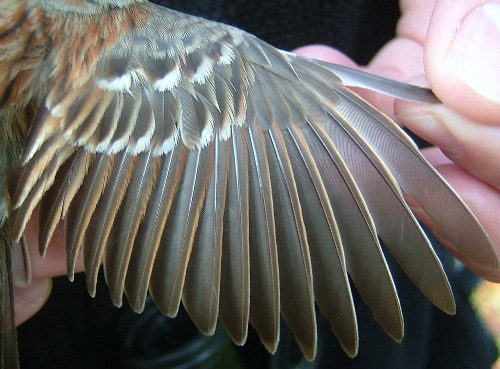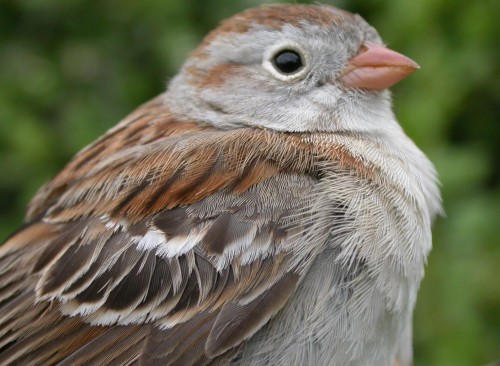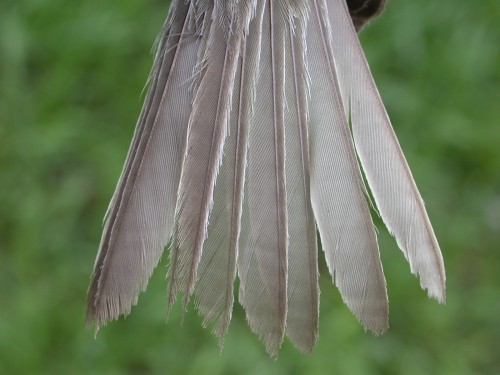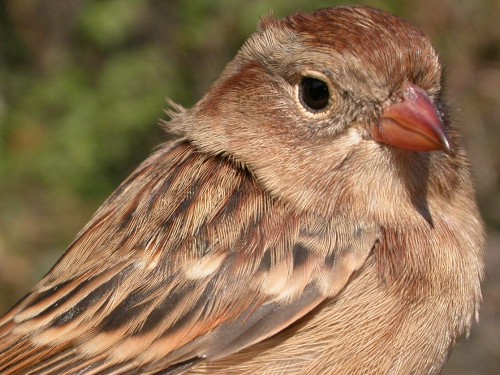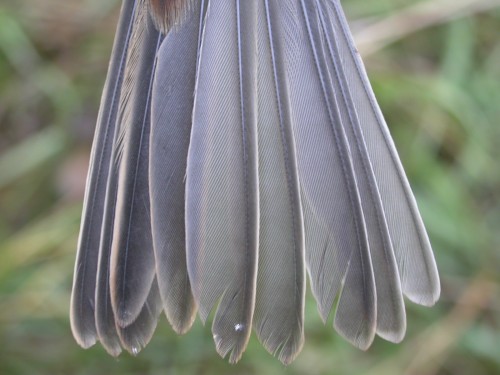|
McGILL BIRD OBSERVATORY |
|||||||||||||
NOTE:
This species account has been moved to Piranga to allow for improved comparison
among examples.
Ageing and sexing details: Overall plumage is not helpful in distinguishing SY and ASY Field Sparrows. Sex can be determined only in the hand by observing a brood patch or cloacal protuberance during the breeding season.
The wing of an ASY Field Sparrow is relatively uniform in quality/wear and colour. The primary coverts are relatively broad and round, and usually have some rufous edging, though it may be very narrow and inconspicuous, as in the photo below.
ASY Field Sparrows have relatively broad and rounded rectrices, but note that some SY birds may have replaced their entire tail, therefore the shape and condition of the rectrices should not be used as the only criterion in support of ASY.
Overall body plumage provides no useful clues to the age of Field Sparrows. Sex can be determined only in the hand by observing a brood patch or cloacal protuberance during the breeding season.
SY Field Sparrows show a contrast between the relatively pale juvenile primary coverts and replaced formative greater coverts. The inner secondaries and outer primaries may also be darker and fresher than the flight feathers in the middle of the wing, but these are poorly visible in this photo.
Field Sparrows replace anywhere between zero and all rectrices during their preformative molt, therefore the presence of any juvenile rectrices indicates a SY bird, but a uniformly adult tail can occur on both SY and ASY birds. In the example below, none of the rectrices have been replaced, as all are narrow, tapered, and rather heavily abraded juvenile feathers.
There are no reliable differences in overall plumage to distinugish HY from AHY Field Sparrows. Sex can be determined for AHY birds only in summer and early fall if brood patches or cloacal protuberances remain visible.
The wing of an AHY Field Sparrow is relatively uniform in quality/wear and colour. The primary coverts are relatively broad and round, and usually have some rufous edging, though it may be very narrow and inconspicuous.
Adult rectrices are relatively broad and rounded.
There are no reliable differences in overall plumage to distinugish HY from AHY Field Sparrows. Sex cannot be determined for HY Field Sparrows.
The primary coverts on HY Field Sparrows are relatively narrow and tapered, with minimal edging. However, their appearance may differ only subtly from those of AHY individuals. A better indicator of age, when present, is an eccentric molt among the primaries. In the photo below, note the contrast betwen the three dull brown inner juvenile primaries, and the darker formative primaries to the right (especially evident by looking at the colour of the feather shaft).
The rectrices of HY Field Sparrows are relatively narrow and tapered; over time they become quite abraded, though some fall birds may look quite fresh, as the example below. Note also that some HY birds may replace all their rectrices during their preformative molt, therefore the tail should be used as an ageing criterion with caution unless the rectrices are a mixture of juvenile and formative feathers, or all are distinctly juvenile.
|








